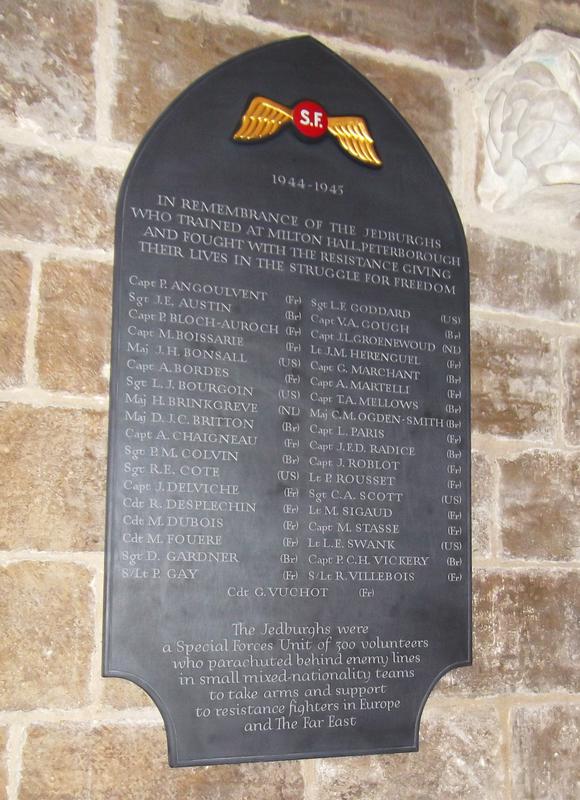Jedburgh Special Forces Unit Plaque
Details:
On the south wall of St Sprite's Chapel.
A rounded-arch topped slate tablet. At the top center is the Jedburgh's insignia, a red circle with the white letters 'S.F.', flanked by golden wings. Beneath are two columns of engraved names and their respective nationalities. The lower corners of the tablet are incut. The plaque is inscribed in English.
In World War II, the Jedburghs were a Special Forces unit of 300 volunteers recruited from the armed forces of Britain (SOE - the Special Operations Executive), America (OSS - Office of Strategic Studies), and France (BCRA - Bureau Central de Renseignements et d'Action) with small contingents from Belgium and Holland. Their task was to parachute in uniform into enemy-occupied territory in small, mixed nationality teams, to arm and train Resistance fighters, and to coordinate their activities with the overall strategy of the Allied D-Day armies' advance out of Normandy (Overlord) and the landings in the South of France (Dragoon).
Milton Hall, near Peterborough, England, was their home base. There in 1944, they underwent months of exhaustive training, covering all aspects of modern guerrilla warfare, ambushes, demolition, unarmed combat, silent killing, small arms, parachuting, and the techniques of reception committee work for receiving additional supplies by air while operating behind enemy lines.
The operational teams themselves, which were formed through a mixture of 'official' nominations and individual choice, usually were composed of either two British or two American Jedburghs, plus one other from the intended country of operation. There were variations on the theme, but whatever the final composition, one member of every team was always a radio operator, proficient in high-speed Morse code and ciphers, the peculiarities of short-wave radios such as the 'B2' and the 'Jed-Set', and the intricacies of running repairs under primitive conditions.
Between June and September 1944, 276 Jedburgh personnel jumped into France, Belgium, and the Netherlands from bases in Great Britain and North Africa. During June and July, they joined the resistance in attacks on German communications within Normandy. Several teams deployed to Brittany, where they worked with British Special Air Service to organize more than 20,000 partisans. When U.S. troops entered the province in August, these guerrillas guided units, protected their flanks, gathered intelligence, and provided a screen against German patrols.
To the east, as Allied armies raced across France in August and early September, French partisans with Jedburgh's assistance ambushed retreating German columns, preserved major installations from demolition, rescued downed Allied pilots, and protected the right flank of the Third Army's rapid advance. Jedburgh officers also gathered valuable intelligence, including plans for German defenses at Lorient and La Rochelle, and information on the V4, a new German secret weapon that used the blast from compressed air against infantry.
In southern France, the Jedburgh-aided partisans supported the Allied landings on the Riviera coast and the Seventh Army's subsequent drive to the Rhone Valley, liberating hosts of jubilant French towns in advance of the Allied forces.
Between D-Day and VE-Day, Jedburgh teams carried out 101 operations in Europe, 93 with the maquis in France in support of the Allied landings, and 8 in the Netherlands of which 6 were in connection with Operation 'Market Garden' (Arnhem). Later the "Jeds", as they liked to call themselves, did many similar operations with other Allied Special Forces such as Force 136 (SOE) and the American OSS in Norway, Italy, Burma, Malaya, Borneo, Indonesia, China, and Indo-China.
Jedburgh dead, as can be seen from the memorial tablet in the Sprite Chapel, numbered 37. Most were killed in action, but some died of wounds and others of illnesses contracted during operations in the jungles of South East Asia. Seven were executed after capture; one, a French officer by being beheaded and another by being bayoneted to death.
Source of information: Imperial War Museum War Memorials Register, www.warmemorialsonline.org.uk, www.cuirass.co.uk
Source of photo: Imperial War Museum War Memorials Register
Monument Text:
1944-1945
IN REMEMBRANCE OF THE JEDBURGHS
WHO TRAINED AT MILTON HALL, PETERBOROUGH
AND FOUGHT WITH THE RESISTANCE GIVING
THEIR LIVES IN THE STRUGGLE FOR FREEDOM
|
Capt P. ANGOULVENT |
(Fr) |
Sgt. L. F. GODDARD |
(US) |
|
Sgt J. E. AUSTIN |
(Br) |
Capt V.A. GOUGH |
(Br) |
|
Capt P. BLOCH-AUROCH |
(Fr) |
Capt J.L. GROENEWOUD |
(NL) |
|
Capt M. BOISSARIE |
(Fr) |
Lt J.M. HERENGUEL |
(Fr) |
|
Maj J. H. BONSALL |
(US) |
Capt G. MARCHANT |
(Br) |
|
Capt A. BORDES |
(Fr) |
Capt. A. MARTELLI |
(Fr) |
|
Sgt L. J. BOURGOIN |
(US) |
Capt. T.A. MELLOWS |
(Br) |
|
Maj H. BRINKGREVE |
(NL) |
Maj C. M. OGDEN-SMITH |
(Br) |
|
Maj D. J. C. BRITTON |
(Br) |
Capt L. PARIS |
(Fr) |
|
Capt A. CHAIGNEAU |
(Fr) |
Capt J.F.D. RADICE |
(Br) |
|
Sgt. P. M. COLVIN |
(Br) |
Capt J. ROBLOT |
(Fr) |
|
Sgt R. E. COTE |
(Fr) |
Lt. P. ROUSSET |
(Fr) |
|
Capt J. DELVICHE |
(Fr) |
Sgt C.A. SCOTT |
(US) |
|
Cdt R. DESPLECHIN |
(Fr) |
Lt M. SIGAUD |
(Fr) |
|
Cdt M. DUBOIS |
(Fr) |
Capt M. STASSE |
(Fr) |
|
Cdt M. FOUERE |
(Fr) |
Lt. L.E. SWANK |
(US) |
|
Sgt D. GARDNER |
(Br) |
Capt P. C.H. VICKERY |
(Br) |
|
S/Lt P. GAY |
(Fr) |
S/Lt R. VILLEBOIS |
(Fr) |
|
Cdt G. VUCHOT (Fr) |
|||
The Jedburghs were
a Special Forces Unit of 300 volunteers
who parachuted behind enemy lines
in small mixed-nationality teams
to take arms and support
to resistance fighters in Europe
and The Far East
Commemorates:
People:
Units:
Office of Strategic Services (OSS)
OSS
Wars:
WWII
Battles:
Operation Jedburgh (OSS Operations)

